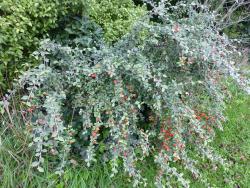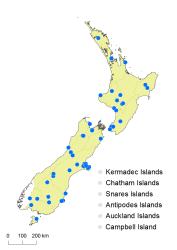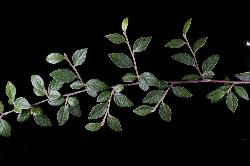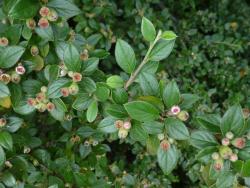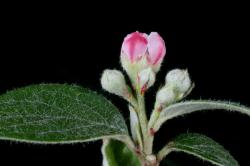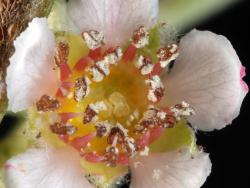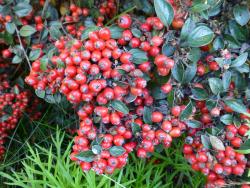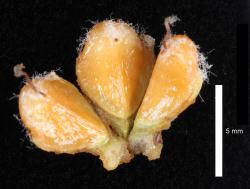- Taxon
- Weed
- Gallery
Erect shrub 1–2 m tall, evergreen. Branches arched; branchlets red-brown, glossy, branchlet hairs dense, white; stipule 2.0–3.8 mm long, red, hairs sparse to dense. Leaves crowded on branches, 30–42 mm long, lamina 19–36(46) mm long, 13–22 mm wide, elliptic, plane, (150–280 µm thick), petiole 3–6 mm long with hairs dense, white to pale yellow, leaf base usually cuneate, occasionally rounded, leaf apex acute, apiculus straight; lateral veins in 3–5 pairs, midvein and lateral veins impressed above and projecting below; upper surface smooth or slightly rugose between lateral veins, moderate olive-green (RHS 137A–B), semi-glossy but dull when young due to hairs, upper surface hairs sparse to moderately dense, white, on young leaves, not persisting; margins plane, hairs dense and white; lower surface not visible due to dense white hairs that persist but become dirty, hairs over the midvein often yellow.
Inflorescence a corymb of (3)7–9(15) flowers, 13–68 mm long, rachis hairs dense, white or yellow; pedicel 1.0–2.0 mm long, hairs dense, white, flowers 5.5–6.0 mm diameter. Hypanthium green, sepals 1.8–2.1 mm long, 1.7–2.8 mm wide, with green or red margins, hairs dense, white. Petals pink to red in bud, when open erect, red centrally, pink on the margins, 4.2–4.8 mm long, 3.4–3.7 mm wide, base clawed, without a tuft of hairs, margins slightly irregular. Stamens 19–21; filaments 1.9–3.0 mm long, pink both before and after opening; anthers 0.6–1.7 mm long, pink to dark pink; styles 2–3, 2.2–3.2 mm long. Fruit vivid reddish-orange to vivid red (RHS 34A–45A), obovoid, 7.8–10.5 mm long, 7.0–9.6 mm in diameter, calyx closed, hairs confined to petiole and calyx, rarely evenly sparse. Pyrenes 2–3 (in about equal proportions on a single plant), 4.6–5.4 mm long, 2.3–4.5 mm wide, hairs abundant at apex, apex umbonate, style attached (0.9)1.4–2.0 mm below pyrene apex.
An upright shrub, 1–2 m tall with spreading, arched branches, leaves 38–42 mm long, elliptic, base and apex acute with a straight apiculus. The leaves are densely white-tomentose on the lower surface, but pale yellow-tomentose on the midvein. The upper leaf surface is rather sparsely hairy and somewhat glossy. Flowers are in small corymbs of 3–15 flowers. Petals are erect, dark pink centrally with pink margins, the petal margins irregular, stamens c. 20, filaments pink, anthers dark pink, styles/pyrenes 2–3, variable in number on a plant, style attached below pyrene apex.
Most similar to Cotoneaster pannosus in being an upright shrub with spreading arched branches, leaves medium-sized and dull, and slightly rugose on the upper surface, the lower leaf surface dense with soft white hairs. Cotoneaster pannosus has leaves indistinguishable from C. franchetii (lamina 14–38 mm × 11–19 mm vs 30–38 × 13–22 mm), and the flowers have erect pink petals, not white spreading petals. Anthers are pink to purple, not white. When sterile the two are virtually indistinguishable, but see notes under C. pannosus.
Also very similar to Cotoneaster amoenus, a much less common species that is not recognised as distinct by some authors, notably Lu & Brach (2003). Both have the same leaf shape and leaf hairs, flowers have erect petals, and the fruit have similar pyrenes, 2–3, with the style attached well below the pyrene apex. The leaves of Cotoneaster amoenus are smaller, c. 25 × 10 mm rather than 30–42 × 13–22 mm. The flowers of C. amoenus have petals that are white and only slightly pink tinged, not dark pink to red centrally and pink on the margins.
Northland (Punakītere, 1984), Auckland (Campbells Bay, 1983; Auckland City), Gisborne (Mātawai, 1979; Eastwoodhill, 1989; Ngatāpa, 1989), Volcanic Plateau (Wairākei, 2006; Taurewa, 1985; Hautapu R, 2003; Taihape, 1990; Raetihi, 1996), Taranaki (Waitaanga Plateau, 1989; Ōakura, 1999), Southern North Island (Whanganui City, 2003; Turakina, 2004; Mt Bruce, 1946; Hutt Valley, 1953; Paremata, 1985; Wellington City, 1993, 1999), Sounds–Nelson (Aniseed Valley, 1991; Nelson City, 1977; Torrent Bay, 1996), Marlborough (Waimā R, 2009), Westland (Owen R, 1997; Greymouth, 1972; Jacksons, 1976), Canterbury (Christchurch City, 1954–2014; Travis Wetland, 2002; Tai Tapu, 1966; Lincoln, 2001; Duvauchelle, 1987; Diamond Harbour, 1987; Little Akaloa, 1987; Bealey Spur, 2016; Arthur’s Pass, 1998; Hororātā, 1986–1989; Peel Forest, 1984; Lake Ōhau, 2004, 2006), Otago (Moeraki, 1997, 2003; Roxburgh, 1957, 1982; Hāwea, 2001; Port Chalmers, 1987; Flagstaff, 2004), Stewart Island (Halfmoon Bay, 2008). Common in cultivation throughout New Zealand.
CHR 54298, M.E. Roberts, 1946, Mt Bruce north of Masterton, in Healy (1958, p. 535)
Flowering: early August to late January; Fruiting: March to June, not persisting on plants over winter. Occasional pale orange-fruited forms are seen in cultivation in Auckland.
Tetraploid (Fryer & Hylmö 2009), confirmed by flow cytometry using CHR 635012



